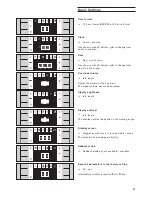
28
Defrosting
Select the “Defrosting” heating mode.
Dish
Cooking insert
Temperature
Cooking time
in °F
in minutes
Berries (1/2 lb)
perforated
110 - 120
3 - 4
Roast (2 lb)
perforated
110 - 120
70 - 80
Fish fillet (1 lb)
perforated
110 - 120
15 - 20
Vegetables (1 lb)
perforated
110 - 120
20 - 30
Goulash (1 lb 4 oz)
perforated
110 - 120
40 - 50
Chicken (2 lb)
perforated
110 - 120
60 - 70
Chicken legs (1 lb)
perforated
110 - 120
30 - 35
After the time has elapsed, leave the food inside the oven for 10-15 minutes after switching off. This ensures the
food is thawed right through.
Tips
– Important! Always insert an unperforated cooking insert one level below the food. Pour out the defrosting liquid
of meat and poultry. Rinse with plenty of water. Clean the cooking insert in hot soapy water or in the
dishwasher.
– The defrosting time depends on the size, weight and shape of the frozen food. Always freeze your food flat or in
single pieces, this shortens the defrosting time.
– Only defrost the amount that you will need to prepare.
– Please observe: defrosted food might not keep and will deteriorate more quickly than fresh food. Immediately
prepare defrosted food and cook it thoroughly.
– Defrosting poultry: take the poultry out of the packaging.
Preserving
Dish
Cooking insert
Temperature
Moisture
Cooking time
in °F
in%
in minutes
Fruit, vegetables (in closed
wire rack
200
100
35
preserving jars)
Tips
– Cook the fruit or vegetables immediately after buying or picking. A prolonged storage will reduce the vitamins
and might lead to fermenting.
– Only use good quality fruit and vegetables.
– Check and clean the preserving jars, rubber seals and clamps.
– Disinfect the clean jars in the oven for 15 minutes at 210°F before using them for preserving.
– Open the oven door after the cooking time has elapsed.
– Leave the jars to cool down completely before taking them out of the oven.
















































